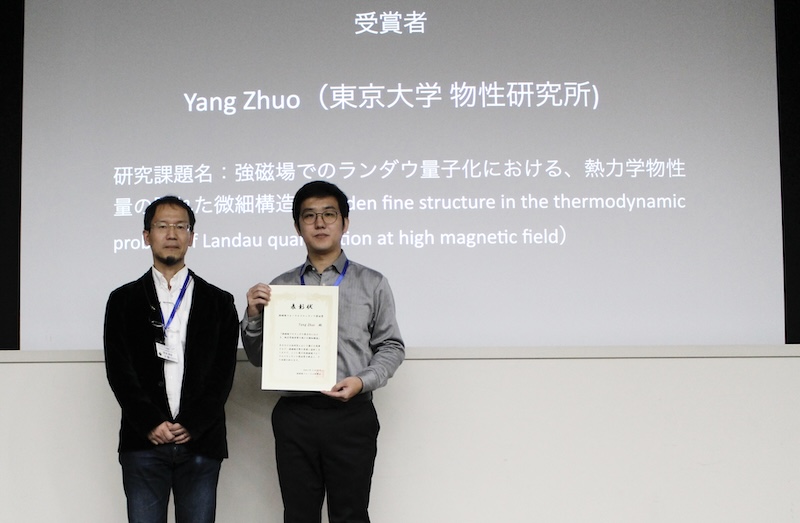Yang Zhuo, a Research associate in Miyata-lab, received The 6th High Magnetic Field Forum Frontier Award for Young Researcher.
Yang Zhuo, a Research associate in Miyata-lab, received The 6th High Magnetic Field Forum Frontier Award for Young Researcher for his work on “Hidden fine structure in the thermodynamic probing of Landau quantization at high magnetic field”. Awards ceremony was held on December 18, 2024 at The Institute for Solid State Physics of the University of Tokyo.
Landau quantization is a well-known method for investigating Fermi surfaces and electronic band structures. In semiconductors, Landau levels are observed through optical transitions (cyclotron resonance), while in metals, quantum oscillations of magnetization or resistance (the de Haas–van Alphen (dHvA) and Shubnikov–de Haas (SdH) effects, respectively) are measured. To enhance the understanding of electronic properties across various materials, there has been a demand for establishing new methods to measure Landau levels as alternatives to cyclotron resonance, dHvA, and SdH.
Entropy measurement techniques, such as specific heat or magnetocaloric effect measurements, have been rarely used to detected quantum oscillations due to their low-resolution. A few reports of quantum oscillation in the thermodynamic probes were only limited to low-field regions that are far from the quantum limit, using superconducting magnets. In this context, he investigated the high-field properties of semimetal graphite and Kondo insulator YbB12 through the high-resolution specific heat and magnetocaloric effect measurements enabled by recently developed high magnetic fields (up to ~50 T). In both materials, he discovered hidden fine structures (double-peak structures) near the quantum limit and successfully provided theoretical interpretations of these fine structures.
In graphite, the double-peak structure that he observed cannot be predicted by the Lifshitz-Kosevich (LK) theory – the standard theoretical framework for quantum oscillations, and he revealed that this hidden double-peak structure originates from the Fermi-Dirac distribution function. Interestingly, the double-peak structure was found to be related to the electron effective mass and Landé g-factor, allowing these physical quantities to be determined independently of the LK theory (Selected Publication[1]). Furthermore, a similar double-peak structure was observed in the high-field specific heat of Kondo insulator YbB12 – a system that lacks free electrons. By combining magnetotransport, magnetocaloric effect, and specific heat in high magnetic field, he proposed that the observed double-peak structures in YbB12 are possibly originated from the charge-neutral fermions, in strictly contrast to simple free electrons (Selected Publication[2]). The origin of these peculiar charge-neutral fermions remains a mystery, with theoretical considerations, it may points to composite excitons or Majorana fermions.
This research impacts not only the understanding of electronic properties but also the broader study of material properties under magnetic fields. For instance, recent high-field studies of Kagome antiferromagnets have shown double-peak structures in specific heat as evidence of magnetic-field-induced spin liquids, suggesting charge-neutral fermions originating from spinon bands (arXiv:2409.05600). The logarithmic divergence of specific heat in temperature sweeps, previously considered evidence for non-Fermi liquids, was also observed along with the double-peak structures in this study. This finding suggests that the research may also influence studies of heavy fermion systems, such as CeRu2Si2, where specific heat logarithmic divergence is frequently observed.
References
- “Unveiling the double-peak structure of quantum oscillations in the specific heat”, Nature Communications 14, 7006 (2023)
- “Evidence for large thermodynamic signatures of in-gap fermionic quasiparticle states in a Kondo insulator”, Nature Communications 15, 7801 (2024)

